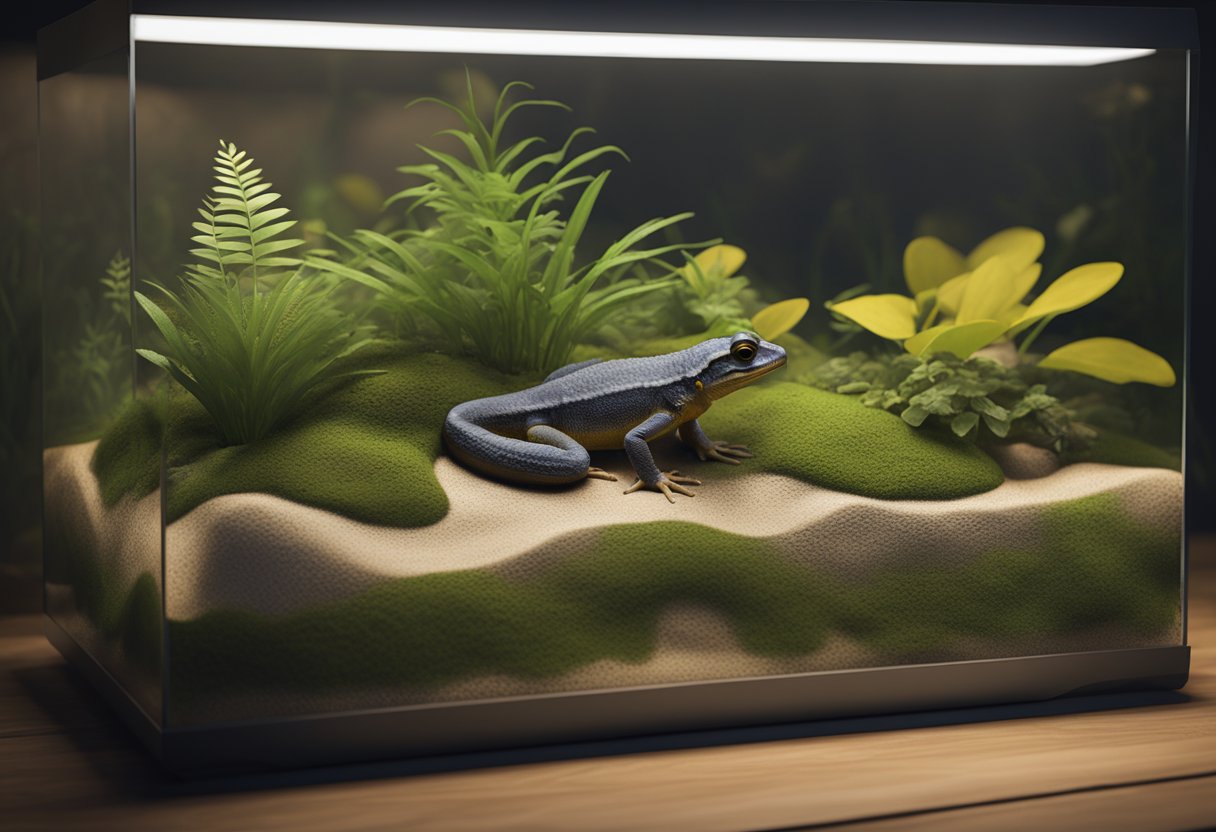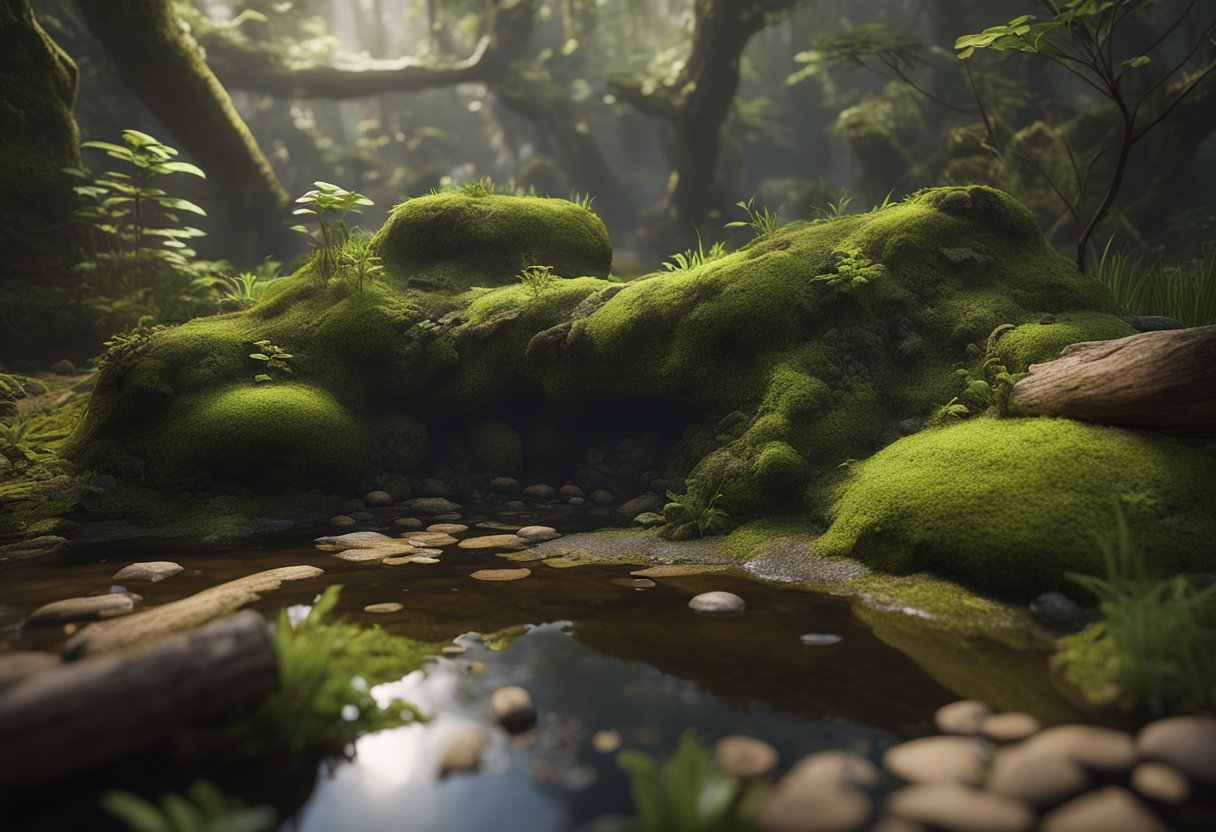Did you know that creating a suitable habitat for your pet newts is essential for their overall well-being? Designing an ideal newt enclosure not only ensures their comfort but also provides a stimulating environment to promote their physical and mental health.
In this comprehensive guide, you will learn everything you need to know about setting up the perfect enclosure for your pet newts. From designing an ideal habitat to choosing the right tank essentials, we’ve got you covered.
Planning the Newt Habitat Design
Before embarking on the setup process for your newt enclosure, it is crucial to carefully plan the design of their habitat. Creating a suitable environment for your newts requires considering various factors that will promote their health, happiness, and natural behaviors. By taking the time to design a well-thought-out habitat, you can provide your newts with a comfortable and stimulating living space that mimics their natural habitat.
When planning the design of your newt habitat, there are several key considerations to keep in mind:
- Tank size: Determine the appropriate tank size based on the number and size of your newts. It’s important to provide enough space for them to swim, explore, and establish territories. Research the specific requirements for the type of newts you will be keeping to ensure they have ample room to thrive.
- Substrate selection: Choose a suitable substrate for the bottom of the tank that will allow your newts to burrow and dig. Avoid gravel or sharp materials that may cause harm. Opt for a substrate that is soft, natural, and easy to clean.
- Hiding spots and climbing structures: Incorporate hiding spots such as rocks, caves, and plants to create a sense of security for your newts. Providing climbing structures like branches or driftwood will allow them to exercise their natural climbing behaviors. Ensure that these elements are securely placed to avoid any potential hazards.
To further enhance the newt habitat design, you can consider adding live plants and natural decorations that replicate their natural environment. Plants not only add aesthetic appeal but also provide hiding places and help maintain water quality by acting as natural filters. Research the type of plants suitable for your newts and ensure they are non-toxic.
Remember, the key to a successful newt habitat design is to create a space that closely resembles their natural habitat, while also providing the necessary elements for their well-being and enrichment. By carefully considering factors such as tank size, substrate selection, and the incorporation of hiding spots and climbing structures, you can create a comfortable and stimulating environment that your newts will thrive in.
| Key Factors to Consider | Benefits |
|---|---|
| Tank size | Allows newts to swim, explore, and establish territories |
| Substrate selection | Enables burrowing and digging behaviors |
| Hiding spots and climbing structures | Provides a sense of security and opportunity for natural behaviors |
| Live plants and natural decorations | Adds aesthetic appeal, hiding places, and helps maintain water quality |
Choosing the Best Newt Tank Layout

The layout of your newt tank is crucial in creating an ideal environment that promotes the comfort and stimulation of your pets. By carefully considering the placement of plants, rocks, and water features, you can design a tank layout that suits the specific needs of your newts. Here are some tips to help you choose the best newt tank layout:
1. Provide Adequate Hiding Spots
Creating hiding spots within your tank layout is essential for newts to feel secure. You can incorporate various hiding options such as caves, logs, or plant foliage. These hiding spots not only provide a safe place for newts to retreat to when they feel stressed or threatened but also add visual interest to the tank.
2. Include Climbing Structures
Newts are known to be skilled climbers. Adding climbing structures, such as branches or driftwood, allows them to engage in their natural behaviors and explore their habitat vertically. Climbing structures also offer newts a way to bask under light sources or reach higher spots in the tank.
3. Balance Open Spaces and Cover
While hiding spots and climbing structures are important, it is equally essential to provide areas with ample open space. Open spaces allow newts to swim and move freely within their enclosure. By striking a balance between open spaces and covered areas, you create an environment that mimics their natural habitat and enhances their overall well-being.
4. Incorporate Live Plants
Live plants not only beautify the newt tank but also serve practical functions. They help maintain high water quality by absorbing excess nutrients and provide newts with natural hiding places. Choose aquatic plants that are compatible with newts and ensure that they do not contain any toxic substances.
“A well-designed newt tank layout provides an enriching and visually appealing environment for your pets to thrive in.”
In summary, the best newt tank layout encompasses hiding spots, climbing structures, a balance between open spaces and cover, and the incorporation of live plants. By considering these factors, you can create a stimulating and comfortable habitat that promotes the overall well-being of your newts.
Essential Newt Tank Setup Steps
Now that you have a clear idea of the design and layout, it’s time to set up your newt terrarium. This section will guide you through the essential steps to create the ideal newt cage setup, ensuring the comfort and well-being of your newts.
Selecting the Right Lighting and Heating Options
Proper lighting and heating are crucial for maintaining the optimal conditions in your newt tank. Newts require a balance of light and darkness, as well as a consistent temperature range. Here are some key considerations:
- Choose a full-spectrum UVB fluorescent light or LED light to provide the necessary UV radiation for your newts’ well-being.
- Set up a temperature gradient in the tank, with a basking spot temperature of around 82°F (28°C) and a cooler area around 70°F (21°C).
- Use a combination of a heat lamp, under-tank heater, and thermostat to maintain a stable and appropriate temperature throughout the enclosure.
Maintaining Proper Water Parameters
Newts are semi-aquatic creatures and require clean, dechlorinated water for swimming and soaking. Consider the following guidelines:
- Fill the tank with chlorine-free water, either through using a water conditioner or letting tap water sit for at least 24 hours.
- Maintain a water depth of at least 4-6 inches to allow your newts to fully submerge.
- Regularly test the water parameters, including pH, ammonia, nitrite, and nitrate levels, to ensure a healthy living environment.
- Change approximately 25% of the water every week to prevent the buildup of waste and maintain good water quality.
Establishing a Balanced Diet for Your Newts
Newts are carnivorous and need a varied diet to meet their nutritional needs. Feeding your newts a balanced diet will help support their overall health and vitality. Consider the following feeding recommendations:
- Offer live or frozen foods such as bloodworms, brine shrimp, daphnia, and small insects to provide essential proteins.
- Include a variety of vitamin and mineral supplements to ensure your newts receive all the necessary nutrients.
- Feed your newts in a separate feeding container to prevent food from contaminating their tank and causing water quality issues.
- Observe your newts’ feeding habits and adjust the portion sizes accordingly to prevent overfeeding or underfeeding.
By following these essential newt tank setup steps, you can create a comfortable and thriving habitat for your newts. Providing the right lighting, maintaining proper water parameters, and establishing a balanced diet will ensure the well-being of your newts and help them thrive in their new environment.
| Lighting and Heating | Water Parameters | Balanced Diet |
|---|---|---|
| Choose full-spectrum UVB fluorescent or LED lights | Fill the tank with clean, dechlorinated water | Offer live or frozen foods such as bloodworms, brine shrimp, and small insects |
| Maintain a temperature gradient in the tank | Maintain a water depth of at least 4-6 inches | Include vitamin and mineral supplements |
| Use a combination of heat lamp, under-tank heater, and thermostat | Regularly test and monitor water parameters | Feed in a separate container to prevent contamination |
Maintaining a Thriving Newt Enclosure
Once you have successfully set up your newt enclosure, it is crucial to provide consistent care to ensure the health and well-being of your beloved pets. By following some essential maintenance tips and practices, you can create a thriving habitat for your newts.
1. Water Quality Monitoring
Regularly monitoring the water quality in your newt enclosure is vital for the overall health of your pets. Use test kits to check the levels of ammonia, nitrite, nitrate, pH, and temperature in the water. Maintaining appropriate water parameters will help prevent stress and disease in your newts.
2. Cleaning Procedures
Keeping the newt enclosure clean is crucial to prevent the buildup of waste and harmful bacteria. Here are some key cleaning tasks:
- Regularly remove uneaten food and feces from the tank to maintain cleanliness.
- Perform partial water changes every week to maintain water quality.
- Clean the tank and decorations with aquarium-safe cleaning agents, ensuring they are free from any chemical residues before placing them back into the enclosure.
3. Handling Tips
When interacting with your newts, it is important to handle them with care to avoid causing them stress or harm. Here are some handling tips to remember:
- Wash your hands thoroughly before handling your newts to prevent the transfer of any contaminants.
- Handle your newts gently and avoid excessive squeezing or gripping.
- Ensure a suitable temperature and humidity environment for your newts during handling to prevent shock.
4. Feeding Schedule
Establishing a proper feeding schedule is crucial for the nutrition and overall well-being of your newts. Feed them a balanced diet consisting of live or frozen foods suitable for their species. Avoid overfeeding, as it can lead to obesity or water pollution. Consult a veterinarian or do thorough research to determine the specific dietary requirements of your newts.
5. Regular Observations
Regularly observe your newts to monitor their behavior, appetite, and overall health. Look out for any signs of illness, such as lethargy, loss of appetite, or skin abnormalities. If you notice any concerning symptoms, consult a veterinarian experienced in amphibian care for proper diagnosis and treatment.
| Newt Enclosure Maintenance Checklist | Frequency |
|---|---|
| Water quality monitoring | Weekly |
| Partial water changes | Weekly |
| Removing uneaten food and feces | Daily |
| Cleaning tank and decorations | Monthly |
| Observing behavior and health | Daily |
By following these maintenance tips, you can create a thriving habitat for your newts and ensure their long-term well-being. Remember, providing proper care and attention to your newt enclosure is essential for keeping your pets happy and healthy.
Conclusion
Setting up a newt enclosure requires careful planning and consideration. By following this beginner-friendly guide, you can create a habitat that meets the specific needs of your newts and provides them with a comfortable and stimulating living space.
Remember to regularly observe and adjust the setup as needed to ensure the well-being of your beloved pets. Keeping a close eye on water quality, temperature, and cleanliness will help maintain a thriving environment for your newts.
With proper design, layout, and maintenance, your newt enclosure can be a fascinating and rewarding addition to your home. Enjoy watching your newts explore their habitat and thrive in their new environment.

